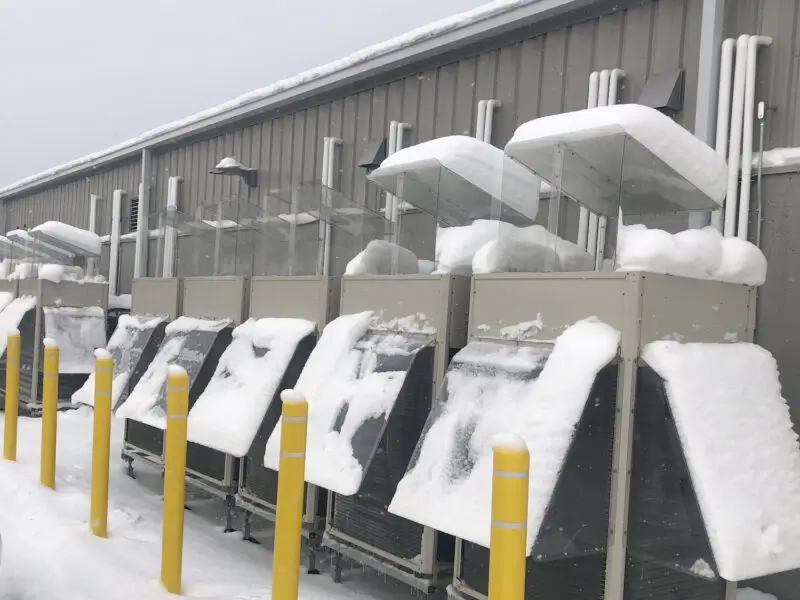
A grow room HVAC-D (Heating, Ventilation, Air Conditioning, and Dehumidification) system is a climate control solution specifically designed for indoor horticulture settings. The purpose of such a system is to create and maintain the optimal environmental conditions for plant growth indoors, irrespective of the external weather or climate.
These systems control the temperature, humidity, air quality, CO2, and ventilation in indoor grow rooms or greenhouses, providing a stable and consistent environment that promotes the healthy growth of plants. They can be used for growing a wide variety of plants, from vegetables and leafy greens to medicinal plants like cannabis, under controlled conditions.
Grow room HVAC systems are more complex than standard HVAC systems as they need to account for factors like lighting, the type of plants being grown, the stages of plant growth, and the heat generated by other equipment in the grow room. They often include additional components such as humidifiers, dehumidifiers, CO2 supplementation equipment, and air purification systems to precisely control all aspects of the indoor growing environment.
Why is HVAC important for indoor gardening or farming?
HVAC systems are crucial for indoor gardening or farming due to several reasons:
- Temperature Control: Differing cannabis strains might require different temperatures to grow optimally. Some strains need cooler environments, while others may require warmer conditions to mimic their natural environment. A VRF HVAC system can maintain a precise temperature in your grow room, enhancing plant health and productivity.
- Humidity Management: Proper humidity levels are vital for plant health. Too much humidity can lead to mold, mildew, and other diseases, while too little can cause plants to wilt. Dehumidifiers and HVAC systems can pull the moisture level in the air, while battling the constant humidifying load in the grow room.
- Air Circulation: Good air circulation, specifically vertical airflow to destratify the air, is essential in a grow room to prevent pests and diseases and to ensure all plants receive an equal amount of CO2. Dedicated air mixing fans and air handlers on VRF HVAC systems help circulate fresh air in the grow room and remove stale air, improving plant health.
- CO2 Supply: Plants need carbon dioxide for photosynthesis. A well-designed HVAC and ventilation system can help regulate CO2 levels in the grow room, ensuring that plants have the resources they need for growth.
- Heat Regulation: Indoor grow lights, especially high-intensity lights, can produce significant heat, with one watt being equivalent to 3.4 Btu/h’s. This heat can be deadly to plants if not properly managed. VRF HVAC systems can help dissipate this excess heat in the most efficient manner possible to maintain consistent temperature settings.
- Consistent Environment: Perhaps the most critical role of HVAC systems is providing a consistent environment without the risk of malfuntion. Fluctuations in temperature, humidity, or CO2 levels can cause stress to plants, leading to lower yields and poorer quality. With an Easy Root’s VRF HVAC system, you can create a stable growing environment year-round, regardless of the outdoor climate from Death Valley, CA to Minneapolis, MN.
By providing these vital controls, HVAC systems can significantly improve the success of indoor gardening or farming, leading to healthier plants and higher yields.
How does a grow room HVAC system work?
A grow room HVAC system works by controlling the temperature, humidity, CO2, and air quality in the grow room or indoor farming area. Here’s a general breakdown of how it functions:
- Heating: These systems are important because they can help to control humidity when the lights are off. Traditionally, growers will keep lights off temperatures 5F to 10F colder than lights on. Being able to manage this setpoint, and the associated humidity levels in the room, requires a system that can both heat and cool. Easy Roots VRF Heat Pumps and Heat Recovery systems are optimal to avoid the extra cost of electric or gas heaters.
- Cooling: Conversely, when the temperature sensor detects that the room is too warm when the grow lights are on, the cooling component of the HVAC system is activated. The system removes heat from the room and expels it outdoors via refrigerant without odors escaping, or outside air coming in.
- Humidity Control: Grow room HVAC systems often include humidifiers and dehumidifiers. If the air in the grow room is too dry, a humidifier adds moisture to the air. If the air is too moist (which can lead to problems with mold and disease), a dehumidifier removes moisture from the air.
- Air Filtration and Ventilation: To provide fresh air for the plants and prevent the buildup of harmful gases or pollutants, grow room HVAC systems use a combination of filters and fans. The filters remove particulates and potentially harmful substances from the air, while the fans help to circulate fresh air and remove stale air from the grow room.
- CO2 Enrichment: Some advanced HVAC systems for grow rooms also include CO2 enrichment systems. These systems add CO2 to the air in the grow room to promote photosynthesis and plant growth.
In sum, the grow room VRF HVAC-D system works by constantly monitoring and adjusting the indoor environment to keep it within the optimal range for plant growth. This involves heating and cooling the air, adjusting its humidity, enriching or exhausting CO2, and ensuring it’s UV sanitized and filtered air.
What size HVAC system do I need for my grow room?
Determining the right size for your grow room HVAC system involves several factors. It’s essential to get the correct size because an undersized system may not maintain the optimal environment, while an oversized system can lead to frequent on-off cycles, inefficient operation, and increased wear and tear. Here are the factors you should consider:
- Size of the Grow Room: Measure the length, width, and height of your grow room to calculate its total volume in cubic feet. This is the starting point for determining the cooling or heating capacity you’ll need, often measured in British Thermal Units (BTUs).
- Lighting: The type and number of grow lights you use will significantly impact the amount of heat in your grow room. More or higher-intensity lights mean more heat, which requires more cooling capacity.
- Number of Plants: More plants can lead to higher humidity and higher transpiration rates, which can influence your HVAC sizing.
- Room Insulation: How well your grow room is insulated will affect how quickly it loses or gains heat. Poorly insulated rooms will require a larger HVAC system.
- Ambient Conditions: Consider the typical outdoor climate where you live. More extreme temperatures or humidity levels will require a more robust HVAC system.
- Other Equipment: Don’t forget to consider other equipment in your grow room that might generate heat, such as CO2 generators or water heaters.
- Target Temperatures: The lower your required temperature or humidity settings, the more capacity you will require.
Once you have gathered this information, it’s recommended to consult with EasyRoots who can help you calculate the necessary HVAC capacity for your grow room. Some online calculators can help you get a rough estimate, but due to the complexity and importance of this calculation, professional guidance is advised.
Note that the needs of your HVAC system can change over time, for instance, as your plants grow or if you change your lighting or other equipment, so you should regularly reassess your HVAC needs.
Can I install a grow room HVAC system myself or do I need a professional?
Whether you can install a grow room HVAC system yourself depends on the complexity of the system, your technical skills, and your understanding of the requirements for a successful installation.
For simple HVAC systems or small-scale grow rooms, a well-informed DIY enthusiast may be able to handle the installation, especially if the system is a plug-and-play type. This can involve setting up portable air conditioners, humidifiers, dehumidifiers, fans, and ducting.
However, for large-scale or commercial grow rooms, or for more complex HVAC systems that include integrated humidity control, CO2 enrichment, and air filtration, professional installation is highly recommended. Here are some reasons why:
- Knowledge and Experience: Professional HVAC installers have the training and experience to properly size and install HVAC systems, ensuring they operate efficiently and effectively.
- Safety: Installing HVAC systems involves working with electrical components, which can be hazardous if not handled correctly. A professional installer knows how to handle these components safely.
- Regulation Compliance: In many areas, HVAC installation must meet certain building codes or regulations. A professional installer will be aware of these requirements and ensure your installation is compliant.
- Equipment Protection: Improper installation can damage the HVAC system and void its warranty. Professional installation helps protect your investment.
- System Optimization: A professional can optimize the system to your specific grow room setup, ensuring optimal performance.
Even if you choose to install your HVAC system yourself, it’s a good idea to consult with a professional beforehand to make sure you’re choosing the right equipment and setting it up correctly. Remember, the performance of your grow room HVAC system has a direct impact on the health and productivity of your plants, so it’s important to get it right.
How often should I service my grow room HVAC system?
How do I maintain my grow room HVAC system for optimal performance?
Are there specific grow room HVAC systems for different plant types?
What features should I look for in a grow room HVAC system?
Can a grow room HVAC system help control pests and diseases in my indoor garden?
How energy-efficient are grow room HVAC systems?
What is the lifespan of a typical grow room HVAC system?
Do you offer warranty and technical support for the HVAC systems?
How does a grow room HVAC system impact plant yield?
What factors can influence the performance of my HVAC system in the grow room?
How do HVAC systems help in managing humidity in the grow room?
Are there special considerations for HVAC systems in commercial grow rooms?
What are the potential issues that can occur with a grow room HVAC system? How can they be diagnosed and resolved?
Make Your Grow More Efficient
Give us a call to schedule a risk-free consultation.
- 833-EASYBUD
Sign up to our Newsletter
(We do not share your data with anybody, and only use it for its intended purpose)

